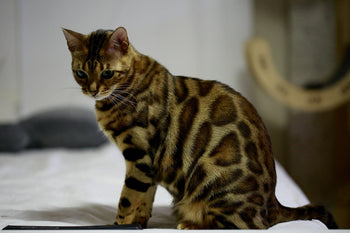Cats are fascinating creatures with unique behaviors that often leave their owners wondering what they are trying to communicate. One such behavior is tail wagging while lying down. Unlike dogs, cats do not typically wag their tails to express happiness or excitement, so what does it mean when they do it while relaxing?
Understanding Cat Tail Language To decipher the meaning behind a cat's tail movements, it is essential to understand their tail language. A cat's tail can communicate a wide range of emotions, from happiness and contentment to fear and aggression. For example, a tail held high indicates confidence and happiness, while a puffed-up tail is a sign of fear or aggression.
Tail Wagging While Lying Down: Possible Reasons When a cat wags its tail while lying down, it could be a sign of several things. One possibility is that the cat is feeling content and relaxed, and the tail movement is simply a reflex action. Another possibility is that the cat is feeling playful and is signaling its desire to play. However, if the tail wagging is accompanied by other signs of aggression, such as growling or hissing, it could be a warning to stay away.
Why Do Cats Wag Their Tails While Lying Down: Explained
Key Takeaways
A cat's tail language can communicate a wide range of emotions, from happiness to aggression.
Tail wagging while lying down could be a sign of contentment, playfulness, or aggression.
Other behavioral and emotional factors should be considered when interpreting a cat's tail movements.

Understanding Cat Tail Language
Cats use their tails to communicate a wide range of emotions and intentions. Understanding cat tail language can help cat owners better understand their pets and provide them with appropriate care.
Significance of Tail Communication
Cats use their tails to communicate a variety of messages, including their mood, intentions, and level of comfort. A cat's tail can indicate if they are feeling relaxed, alert, playful, or aggressive. It can also signal if they are in pain, stressed, or afraid.
Tail Positions and Meanings
The position of a cat's tail can reveal a lot about their mood and intentions. Here are some common tail positions and their meanings:
Straight up: A cat with their tail straight up is feeling confident and happy.
Curved tip: A cat with a slightly curved tip of their tail is feeling friendly and playful.
Puffed up: A cat with their tail puffed up is feeling threatened or frightened.
Tucked under the body: A cat with their tail tucked under their body is feeling scared or submissive.
Lashing or thrashing: A cat with a lashing or thrashing tail is feeling agitated or angry.
Misconceptions About Tail Wagging
Contrary to popular belief, tail wagging in cats does not always indicate happiness or excitement. In fact, a cat wagging their tail can be a sign of frustration, irritation, or aggression. It is important for cat owners to pay attention to other body language cues to accurately interpret their cat's emotions.
By understanding cat tail language, cat owners can better communicate with their pets and provide them with appropriate care and attention.
Tail Wagging While Lying Down: Possible Reasons
Cats are known for their unique behaviors, and tail wagging is one of them. While most people associate tail wagging with dogs, cats also wag their tails. In fact, cats can wag their tails for various reasons, including when they are lying down. Here are some possible reasons why cats wag their tails while lying down:
Reasons for Tail Wagging
Cats can wag their tails for different reasons, including expressing emotions, communicating with other cats, or responding to stimuli. When a cat is lying down and wagging its tail, it could be expressing contentment or irritation. It is essential to observe the cat's body language and other cues to determine the reason for tail wagging.
Connection to Relaxation
Cats are known for being relaxed and calm animals, and tail wagging while lying down could be a sign of relaxation. When a cat is lying down and wagging its tail slowly, it could indicate that the cat is comfortable and at ease. However, if the tail is twitching or lashing, it could be a sign of agitation or discomfort.
Response to Stimuli
Cats can also wag their tails in response to stimuli, such as sounds or movements. When a cat is lying down and wagging its tail rapidly, it could be a sign that the cat is alert and responding to something in its environment. It is essential to observe the cat's behavior and surroundings to determine the reason for tail wagging.
In conclusion, tail wagging while lying down is a common behavior in cats, and it can have different meanings depending on the context. By observing the cat's body language and other cues, it is possible to determine the reason for tail wagging and understand the cat's behavior better.
Behavioral and Emotional Factors

Role of Behavioral Factors
Cats are known for their complex behavior, and tail movements are an important part of their communication. When a cat wags its tail while lying down, it may be a sign of various behavioral factors, including playfulness, curiosity, and aggression.
Playful cats may wag their tails while lying down as a way to indicate their excitement or anticipation. Similarly, curious cats may wag their tails while exploring their surroundings, as they observe and analyze their environment.
On the other hand, aggressive cats may also wag their tails while lying down, but in a different manner. They may hold their tail low and twitch it aggressively, which can be a sign of impending attack or aggression.
Stress and Anxiety Indicators
Cats may also wag their tails while lying down as a response to stress or anxiety. When a cat is feeling stressed or anxious, it may exhibit various behavioral changes, including increased grooming, hiding, or aggression.
Tail movements can also be an indicator of stress or anxiety. For instance, a cat that is feeling anxious may hold its tail low and twitch it rapidly, while a stressed cat may hold its tail high and flick it back and forth.
Interpreting Tail Movements
Interpreting a cat's tail movements can be a challenging task, as different movements can indicate different emotions or behaviors. However, there are some general guidelines that can help pet owners understand their cat's behavior.
For instance, a cat that is wagging its tail while lying down may be indicating playfulness or curiosity, while a cat that is holding its tail low and twitching it may be feeling aggressive or stressed.
Overall, understanding a cat's behavior and emotions can help pet owners provide better care and support for their furry friend. By observing their cat's tail movements and other behavioral cues, pet owners can develop a deeper understanding of their pet's needs and preferences.
Conclusion
In conclusion, cats wag their tails while lying down for various reasons. It could be a sign of contentment, excitement, or even frustration. Understanding the different tail movements and their meanings can help cat owners better communicate with their furry friends.
It's important to note that tail wagging is not always a positive sign. If a cat's tail is twitching rapidly or lashing back and forth, it could be a sign of aggression or fear. In these cases, it's best to give the cat some space and avoid approaching them until they calm down.
Overall, tail wagging is just one of the many ways that cats communicate with us and each other. By paying attention to their body language and behavior, we can better understand their needs and emotions, leading to a stronger bond between cat and owner.

Frequently Asked Questions
What does it mean when a cat wags its tail while resting?
Cats may wag their tails while lying down as a way to communicate with their surroundings. It can indicate that they are aware of their environment and on alert for any potential threats. However, tail wagging can also be a sign of discomfort or irritation.
Is tail wagging a sign of happiness in cats when they are lying down?
Tail wagging in cats can indicate a range of emotions, including happiness, but it is not always a clear indicator of a positive mood. When a cat is lying down and wagging its tail, it is important to look at other body language cues to determine their overall emotional state.
Can tail movement indicate irritation in a cat while it's lying down?
Yes, tail movement in cats can indicate irritation or discomfort. If a cat's tail is twitching or flicking while they are lying down, it may be a sign that they are feeling annoyed or agitated.
What is the significance of a cat flicking the tip of its tail when lying down?
Flicking the tip of the tail while lying down can be a sign of anticipation or excitement in cats. It may also indicate that they are feeling playful or curious about their surroundings.
How does a cat's tail wagging differ when they are relaxed versus when they are annoyed?
When a cat is relaxed, their tail may be still or softly swaying. In contrast, an annoyed cat may have a more aggressive tail movement, such as twitching or lashing back and forth.
Why might a cat thump its tail on the ground while in a lying position?
Thumping the tail on the ground while lying down can be a sign of frustration or aggression in cats. It may indicate that they are feeling threatened or uncomfortable in their environment.















